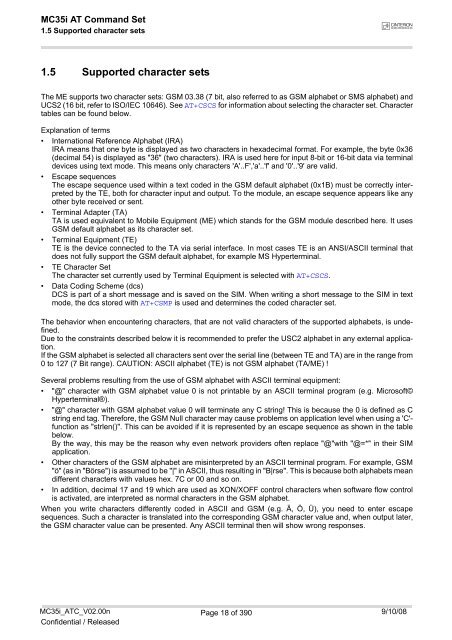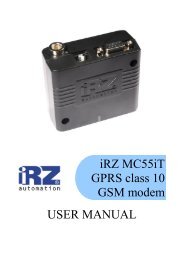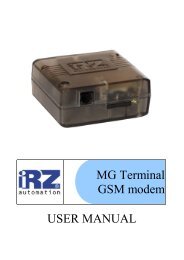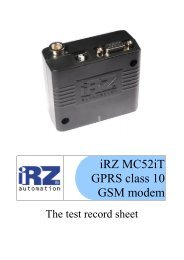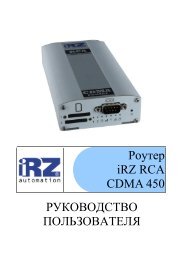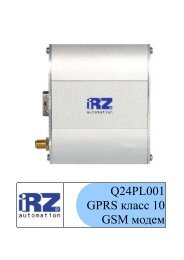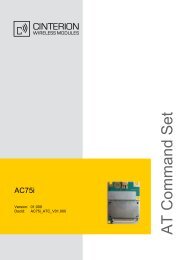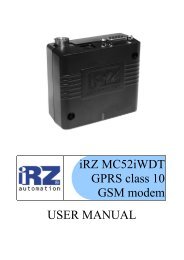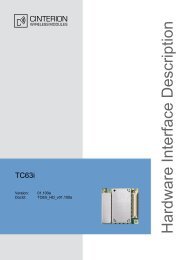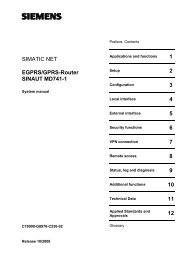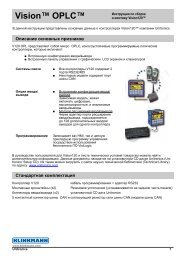- Page 1 and 2: MC35i ModuleMC35i TerminalVersion:
- Page 3 and 4: MC35i AT Command SetContentsContent
- Page 5: MC35i AT Command SetContents6.10 AT
- Page 8: MC35i AT Command SetContents14. SIM
- Page 11 and 12: MC35i AT Command SetList of Figures
- Page 13 and 14: MC35i AT Command Set1.2 Related doc
- Page 15 and 16: MC35i AT Command Set1.3 Document co
- Page 17: MC35i AT Command Set1.4 AT Command
- Page 24 and 25: MC35i AT Command Set1.6 Serial Inte
- Page 26 and 27: MC35i AT Command Set1.8 Errors and
- Page 28 and 29: MC35i AT Command Set2.2 AT&V2.2 AT&
- Page 30 and 31: MC35i AT Command Set2.3 AT&W2.3 AT&
- Page 32 and 33: MC35i AT Command Set2.5 ATV2.5 ATV
- Page 34 and 35: MC35i AT Command Set2.7 ATZ2.7 ATZ
- Page 36 and 37: MC35i AT Command Set2.8 AT+CFUNUnso
- Page 38 and 39: MC35i AT Command Set2.8 AT+CFUNAT+C
- Page 40 and 41: MC35i AT Command Set2.9 AT^SMSO2.9
- Page 42 and 43: MC35i AT Command Set2.11 AT+CMEE2.1
- Page 44 and 45: MC35i AT Command Set2.11 AT+CMEE Co
- Page 46 and 47: MC35i AT Command Set2.11 AT+CMEE Co
- Page 48 and 49: MC35i AT Command Set2.13 AT^SCFG2.1
- Page 50 and 51: MC35i AT Command Set2.13 AT^SCFG (s
- Page 52 and 53: MC35i AT Command Set2.13 AT^SCFGNot
- Page 54 and 55: MC35i AT Command Set2.14 AT^SM202.1
- Page 56 and 57: MC35i AT Command Set3.1 AT+CMERPara
- Page 58 and 59: MC35i AT Command Set3.2 AT+CIND (st
- Page 60 and 61: MC35i AT Command Set3.3 AT^SIND3.3
- Page 62 and 63: MC35i AT Command Set3.4 AT+CEER3.4
- Page 64 and 65: MC35i AT Command Set3.4 AT+CEERIDDe
- Page 66 and 67: MC35i AT Command Set3.4 AT+CEERNumb
- Page 68 and 69:
MC35i AT Command Set3.4 AT+CEERNumb
- Page 70 and 71:
MC35i AT Command Set3.4 AT+CEER3.4.
- Page 72 and 73:
MC35i AT Command Set3.5 ATS183.5 AT
- Page 74 and 75:
MC35i AT Command Set3.6 AT+CPAS3.6
- Page 76 and 77:
MC35i AT Command Set4. Serial Inter
- Page 78 and 79:
MC35i AT Command Set4.3 AT&D4.3 AT&
- Page 80 and 81:
MC35i AT Command Set4.5 ATE4.5 ATE
- Page 82 and 83:
MC35i AT Command Set4.6 AT+ILRR1920
- Page 84 and 85:
MC35i AT Command Set4.7 AT+IPR19200
- Page 86 and 87:
MC35i AT Command Set4.8 AT+CMUX4.8
- Page 88 and 89:
MC35i AT Command Set4.8 AT+CMUXTabl
- Page 90 and 91:
MC35i AT Command Set5.1 AT+CPINPara
- Page 92 and 93:
MC35i AT Command Set5.1 AT+CPINNumb
- Page 94 and 95:
MC35i AT Command Set5.2 AT+CPIN2Not
- Page 96 and 97:
MC35i AT Command Set5.3 AT^SPIC (st
- Page 98 and 99:
MC35i AT Command Set5.3 AT^SPICat+c
- Page 100 and 101:
MC35i AT Command Set5.4 AT+CLCK: Us
- Page 102 and 103:
MC35i AT Command Set5.4 AT+CLCK64 d
- Page 104 and 105:
MC35i AT Command Set5.5 AT^SLCK5.5
- Page 106 and 107:
MC35i AT Command Set5.6 AT+CPWD"PS"
- Page 108 and 109:
MC35i AT Command Set5.6 AT+CPWDEXAM
- Page 110 and 111:
MC35i AT Command Set6. Identificati
- Page 112 and 113:
MC35i AT Command Set6.4 AT+CGMM6.4
- Page 114 and 115:
MC35i AT Command Set6.8 AT+CGSN6.8
- Page 116 and 117:
MC35i AT Command Set7. Call related
- Page 118 and 119:
MC35i AT Command Set7.2 ATD (str)St
- Page 120 and 121:
MC35i AT Command Set7.3 ATD>Notes
- Page 122 and 123:
MC35i AT Command Set7.5 ATD>7.5 ATD
- Page 124 and 125:
MC35i AT Command Set7.7 ATDL7.7 ATD
- Page 126 and 127:
MC35i AT Command Set7.9 AT+CHUP7.9
- Page 128 and 129:
MC35i AT Command Set7.10 AT^SHUPNot
- Page 130 and 131:
MC35i AT Command Set7.12 ATS67.12 A
- Page 132 and 133:
MC35i AT Command Set7.14 ATS87.14 A
- Page 134 and 135:
MC35i AT Command Set7.16 ATO7.16 AT
- Page 136 and 137:
MC35i AT Command Set7.18 AT+CBST7.1
- Page 138 and 139:
MC35i AT Command Set7.20 AT+CLCC7.2
- Page 140 and 141:
MC35i AT Command Set7.21 AT+CR7.21
- Page 142 and 143:
MC35i AT Command Set7.23 AT+CSNS7.2
- Page 144 and 145:
MC35i AT Command Set7.25 AT^SLCD7.2
- Page 146 and 147:
MC35i AT Command Set7.27 ATP7.27 AT
- Page 148 and 149:
MC35i AT Command Set8.2 AT+COPS8.2
- Page 150 and 151:
MC35i AT Command Set8.2 AT+COPSNote
- Page 152 and 153:
MC35i AT Command Set8.3 AT+CREG (nu
- Page 154 and 155:
MC35i AT Command Set8.4 AT+CSQ8.4 A
- Page 156 and 157:
MC35i AT Command Set8.5 AT^SMONC (n
- Page 158 and 159:
MC35i AT Command Set8.6 AT^MONI•
- Page 160 and 161:
MC35i AT Command Set8.7 AT^MONP8.7
- Page 162 and 163:
MC35i AT Command Set8.8 AT^SMONG8.8
- Page 164 and 165:
MC35i AT Command Set8.9 AT^SHOM8.9
- Page 166 and 167:
MC35i AT Command Set8.11 AT^SPLR8.1
- Page 168 and 169:
MC35i AT Command Set9. Supplementar
- Page 170 and 171:
MC35i AT Command Set9.2 AT^SACMThre
- Page 172 and 173:
MC35i AT Command Set9.4 AT+CAOC9.4
- Page 174 and 175:
MC35i AT Command Set9.5 AT+CCUG (nu
- Page 176 and 177:
MC35i AT Command Set9.6 AT+CCFC (st
- Page 178 and 179:
MC35i AT Command Set9.6 AT+CCFC•
- Page 180 and 181:
MC35i AT Command Set9.7 AT+CCWAPara
- Page 182 and 183:
MC35i AT Command Set9.7 AT+CCWAExam
- Page 184 and 185:
MC35i AT Command Set9.8 AT+CHLDNote
- Page 186 and 187:
MC35i AT Command Set9.9 AT+CLIP (nu
- Page 188 and 189:
MC35i AT Command Set9.11 AT+CPUC9.1
- Page 190 and 191:
MC35i AT Command Set9.12 AT+CSSN9.1
- Page 192 and 193:
MC35i AT Command Set9.13 AT+CUSD9.1
- Page 194 and 195:
MC35i AT Command Set10. GPRS Comman
- Page 196 and 197:
MC35i AT Command Set10.2 AT+CGATT10
- Page 198 and 199:
MC35i AT Command Set10.3 AT+CGDATAN
- Page 200 and 201:
MC35i AT Command Set10.4 AT+CGDCONT
- Page 202 and 203:
MC35i AT Command Set10.6 AT+CGQMIN1
- Page 204 and 205:
MC35i AT Command Set10.6 AT+CGQMIN1
- Page 206 and 207:
MC35i AT Command Set10.7 AT+CGQREQ1
- Page 208 and 209:
MC35i AT Command Set10.7 AT+CGQREQ6
- Page 210 and 211:
MC35i AT Command Set10.8 AT+CGREG10
- Page 212 and 213:
MC35i AT Command Set10.9 AT+CGSMS10
- Page 214 and 215:
MC35i AT Command Set10.10 AT^SGACT
- Page 216 and 217:
MC35i AT Command Set10.12 AT^SGCONF
- Page 218 and 219:
MC35i AT Command Set10.14 ATD*98#10
- Page 220 and 221:
MC35i AT Command Set10.16 Using GPR
- Page 222 and 223:
MC35i AT Command Set10.17 Using the
- Page 224 and 225:
MC35i AT Command Set11.1 FAX parame
- Page 226 and 227:
MC35i AT Command Set11.2 AT+FBADLIN
- Page 228 and 229:
MC35i AT Command Set11.4 AT+FBOR11.
- Page 230 and 231:
MC35i AT Command Set11.6 AT+FCLASS1
- Page 232 and 233:
MC35i AT Command Set11.8 AT+FCR11.8
- Page 234 and 235:
MC35i AT Command Set11.10 AT+FDFFC1
- Page 236 and 237:
MC35i AT Command Set11.12 AT+FDR11.
- Page 238 and 239:
MC35i AT Command Set11.14 AT+FET11.
- Page 240 and 241:
MC35i AT Command Set11.16 AT+FLID11
- Page 242 and 243:
MC35i AT Command Set11.18 AT+FMFR11
- Page 244 and 245:
MC35i AT Command Set11.20 AT+FPHCTO
- Page 246 and 247:
MC35i AT Command Set11.22 AT+FRH11.
- Page 248 and 249:
MC35i AT Command Set11.24 AT+FRS11.
- Page 250 and 251:
MC35i AT Command Set11.26 AT+FTM11.
- Page 252 and 253:
MC35i AT Command Set11.28 AT+FVRFC1
- Page 254 and 255:
MC35i AT Command Set12.1 SMS parame
- Page 256 and 257:
MC35i AT Command Set12.1 SMS parame
- Page 258 and 259:
MC35i AT Command Set12.3 AT+CMGD12.
- Page 260 and 261:
MC35i AT Command Set12.5 AT+CMGL12.
- Page 262 and 263:
MC35i AT Command Set12.6 AT+CMGR12.
- Page 264 and 265:
MC35i AT Command Set12.7 AT+CMGS12.
- Page 266 and 267:
MC35i AT Command Set12.8 AT+CMGW12.
- Page 268 and 269:
MC35i AT Command Set12.9 AT+CMSS12.
- Page 270 and 271:
MC35i AT Command Set12.11 AT+CNMI12
- Page 272 and 273:
MC35i AT Command Set12.11 AT+CNMI2
- Page 274 and 275:
MC35i AT Command Set12.12 AT+CPMSNo
- Page 276 and 277:
MC35i AT Command Set12.14 AT+CSCB12
- Page 278 and 279:
MC35i AT Command Set12.16 AT+CSMP12
- Page 280 and 281:
MC35i AT Command Set12.17 AT+CSMS12
- Page 282 and 283:
MC35i AT Command Set12.18 AT^SLMS12
- Page 284 and 285:
MC35i AT Command Set12.20 AT^SMGO12
- Page 286 and 287:
MC35i AT Command Set12.21 AT^SMGR12
- Page 288 and 289:
MC35i AT Command Set12.23 AT^SSDA12
- Page 290 and 291:
MC35i AT Command Set13. SIM related
- Page 292 and 293:
MC35i AT Command Set13.1 AT+CRSM (n
- Page 294 and 295:
MC35i AT Command Set13.2 AT^SCKS2 T
- Page 296 and 297:
MC35i AT Command Set13.4 AT^SCID13.
- Page 298 and 299:
MC35i AT Command Set14. SIM Applica
- Page 300 and 301:
MC35i AT Command Set14.2 ^SSTN14.2
- Page 302 and 303:
MC35i AT Command Set14.4 AT^SSTR14.
- Page 304 and 305:
MC35i AT Command Set15.2 AT+CPBR15.
- Page 306 and 307:
MC35i AT Command Set15.2 AT+CPBRExa
- Page 308 and 309:
MC35i AT Command Set15.3 AT+CPBS"MC
- Page 310 and 311:
MC35i AT Command Set15.4 AT+CPBW (n
- Page 312 and 313:
MC35i AT Command Set15.5 AT^SPBC15.
- Page 314 and 315:
MC35i AT Command Set15.7 AT^SPBG15.
- Page 316 and 317:
MC35i AT Command Set15.7 AT^SPBGNot
- Page 318 and 319:
MC35i AT Command Set15.8 AT^SPBSAft
- Page 320 and 321:
MC35i AT Command Set15.8 AT^SPBSEXA
- Page 322 and 323:
MC35i AT Command Set16. Audio Comma
- Page 324 and 325:
MC35i AT Command Set16.4 AT+CLVL16.
- Page 326 and 327:
MC35i AT Command Set16.6 AT+VTD16.6
- Page 328 and 329:
MC35i AT Command Set16.8 AT^SAIC16.
- Page 330 and 331:
MC35i AT Command Set16.9 AT^SNFA16.
- Page 332 and 333:
MC35i AT Command Set16.10 AT^SNFD16
- Page 334 and 335:
MC35i AT Command Set16.12 AT^SNFM16
- Page 336 and 337:
MC35i AT Command Set16.13 AT^SNFONo
- Page 338 and 339:
MC35i AT Command Set16.15 AT^SNFS16
- Page 340 and 341:
MC35i AT Command Set16.15 AT^SNFSAT
- Page 342 and 343:
MC35i AT Command Set16.17 AT^SNFW16
- Page 344 and 345:
MC35i AT Command Set16.18 AT^SRTCPa
- Page 346 and 347:
MC35i AT Command Set16.19 AT^SNFGPa
- Page 348 and 349:
MC35i AT Command Set17.1 AT+CALARef
- Page 350 and 351:
MC35i AT Command Set17.2 AT+CCLK17.
- Page 352 and 353:
MC35i AT Command Set17.3 AT^SBC (nu
- Page 354 and 355:
MC35i AT Command Set17.4 AT^SCTMSel
- Page 356 and 357:
MC35i AT Command Set17.5 AT^SSYNC17
- Page 358 and 359:
MC35i AT Command Set18. Miscellaneo
- Page 360 and 361:
MC35i AT Command Set18.3 ATS418.3 A
- Page 362 and 363:
MC35i AT Command Set19. Appendix19.
- Page 364 and 365:
MC35i AT Command Set19.2 Star-Hash
- Page 366 and 367:
MC35i AT Command Set19.3 Available
- Page 368 and 369:
MC35i AT Command Set19.3 Available
- Page 370 and 371:
MC35i AT Command Set19.3 Available
- Page 372 and 373:
MC35i AT Command Set19.4 Availabili
- Page 374 and 375:
MC35i AT Command Set19.4 Availabili
- Page 376 and 377:
MC35i AT Command Set19.4 Availabili
- Page 378 and 379:
MC35i AT Command Set19.5 AT Command
- Page 380 and 381:
MC35i AT Command Set19.5 AT Command
- Page 382 and 383:
MC35i AT Command Set19.6 Factory De
- Page 384 and 385:
MC35i AT Command Set19.7 Summary of
- Page 386 and 387:
MC35i AT Command Set19.8 Alphabetic
- Page 388 and 389:
MC35i AT Command Set19.8 Alphabetic
- Page 390:
MC35i AT Command Set19.8 Alphabetic


